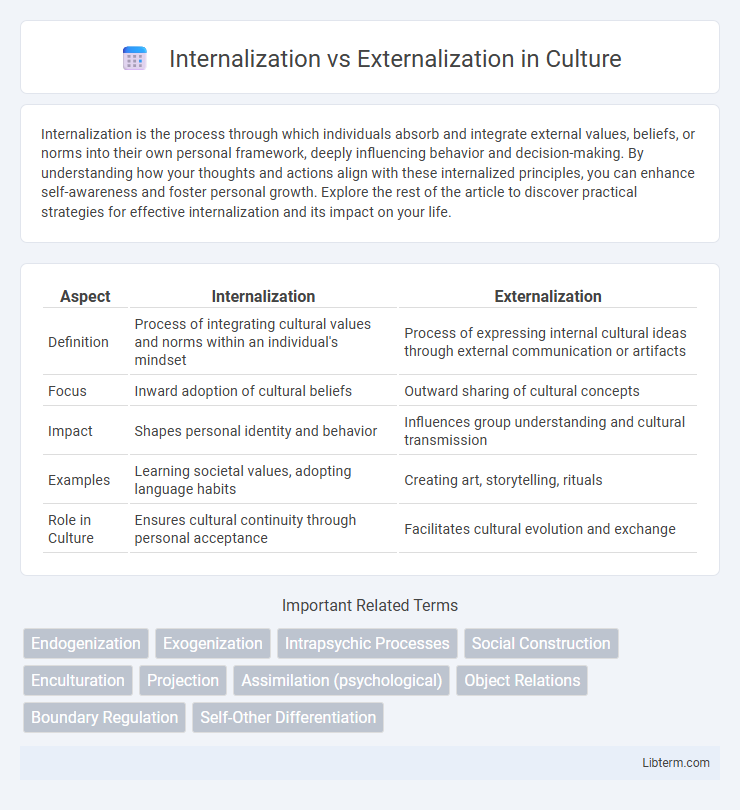Internalization is the process through which individuals absorb and integrate external values, beliefs, or norms into their own personal framework, deeply influencing behavior and decision-making. By understanding how your thoughts and actions align with these internalized principles, you can enhance self-awareness and foster personal growth. Explore the rest of the article to discover practical strategies for effective internalization and its impact on your life.
Table of Comparison
| Aspect | Internalization | Externalization |
|---|---|---|
| Definition | Process of integrating cultural values and norms within an individual's mindset | Process of expressing internal cultural ideas through external communication or artifacts |
| Focus | Inward adoption of cultural beliefs | Outward sharing of cultural concepts |
| Impact | Shapes personal identity and behavior | Influences group understanding and cultural transmission |
| Examples | Learning societal values, adopting language habits | Creating art, storytelling, rituals |
| Role in Culture | Ensures cultural continuity through personal acceptance | Facilitates cultural evolution and exchange |
Understanding Internalization and Externalization
Internalization involves integrating external knowledge, values, or skills into one's own cognitive framework, enabling individuals or organizations to adapt and apply them internally. Externalization refers to the process of articulating or expressing tacit knowledge into explicit forms, such as documents or models, facilitating communication and sharing with others. Understanding these concepts is crucial for effective knowledge management and enhancing organizational learning.
Key Differences Between Internalization and Externalization
Internalization involves integrating external knowledge or processes into an organization's internal framework to enhance capabilities and control, while externalization refers to transferring internal activities or knowledge to external entities to leverage specialized expertise or reduce costs. Key differences include control level, with internalization maintaining direct oversight and externalization relying on third parties, and risk exposure, where internalization carries internal operational risks and externalization introduces dependency on external partners. Cost implications also differ, as internalization may require higher upfront investment in resources, whereas externalization often offers scalability and cost efficiency through outsourcing.
Psychological Foundations of Internalization
Internalization involves integrating external norms, beliefs, and values into one's own psychological framework, shaping identity and behavior from within. Psychological foundations of internalization emphasize processes such as social learning, cognitive development, and motivation, enabling individuals to autonomously regulate actions based on internal standards. This contrasts with externalization, where behaviors or thoughts are projected outward, often as defense mechanisms or coping strategies, highlighting different pathways in psychological adaptation and identity formation.
The Role of Externalization in Behavior
Externalization plays a critical role in behavior by attributing personal challenges or failures to external factors, which can influence coping strategies and interpersonal relationships. It often serves as a defense mechanism by shifting blame and reducing personal accountability, potentially hindering self-reflection and growth. Understanding externalization is essential for developing therapeutic approaches that promote healthier behavioral responses and emotional regulation.
Internalization in Learning and Development
Internalization in Learning and Development represents the deep assimilation of knowledge, skills, and attitudes, enabling learners to apply new concepts autonomously. This process strengthens cognitive structures through repeated practice, reflection, and meaningful engagement with content, leading to long-term retention and behavior change. Internalization contrasts with externalization by emphasizing the transformation of external information into intrinsic understanding, fostering expert performance and self-directed learning within organizations.
Impacts of Externalization on Relationships
Externalization often leads to fragmented communication patterns, undermining trust and collaboration between stakeholders. This process can create barriers by shifting responsibilities outward, resulting in decreased accountability and potential conflicts. The erosion of direct interaction diminishes relationship quality and hampers long-term partnership stability.
Factors Influencing Internalization vs Externalization
Factors influencing internalization include organizational control, proprietary technology, and the need to protect intellectual property, which drive firms to keep activities in-house. Externalization is favored when cost efficiency, access to specialized skills, and flexibility in scaling operations are prioritized through outsourcing or partnerships. Market conditions, transaction costs, and regulatory environments also critically impact the decision between internalizing or externalizing business functions.
Benefits and Drawbacks of Each Approach
Internalization ensures greater control over processes and quality, leading to enhanced security and proprietary knowledge retention, but it demands significant capital investment and operational complexity. Externalization offers cost efficiency and access to specialized expertise, promoting flexibility and scalability, yet it risks loss of control, potential confidentiality breaches, and dependency on third-party vendors. Choosing between internalization and externalization hinges on balancing the trade-offs between control, cost, expertise, and risk management according to organizational goals.
Practical Applications in Therapy and Education
Internalization in therapy and education involves integrating new knowledge or behaviors into an individual's existing cognitive framework, enhancing long-term retention and personal growth. Externalization focuses on expressing internal thoughts and emotions outwardly, facilitating self-awareness and communication through techniques such as journaling or group discussions. Practical applications include cognitive-behavioral therapy where internalization fosters adaptive thinking, while educational settings use externalization to encourage collaborative learning and problem-solving.
Choosing Between Internalization and Externalization
Choosing between internalization and externalization depends on cost efficiency, control requirements, and strategic priorities. Internalization offers full control over operations and intellectual property but demands higher upfront investment and resource allocation. Externalization leverages external expertise and reduces operational costs while potentially sacrificing some control and increasing dependency on third parties.
Internalization Infographic

 libterm.com
libterm.com